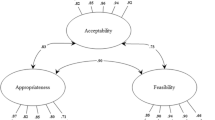Abstract
We present and test a model for measuring the implementation of Community Support Programs (CSPs) for persons with severe mental illnesses. The model is intended to facilitate the description and replication of these programs and the future study of their critical ingredients. The model defines important implementation variables in seven areas of program functioning; we then suggest instruments to measure each of these variables. Results of a study examining the application of the model and measures forthree conceptually distinct CSPs illustrate the utility of the model and measures for implementation analysis of CSPs. Importantly, findings revealed thata priori hypotheses about how the programs were expected to differ on the implementation variables were largely supported.
Similar content being viewed by others
References
Anthony, W.A., & Blanch, A (1989). Research on community support services: What have we learned? Psychosocial Rehabilitation Journal, 12(3), 55–82.
Brekke, J.S. & Aisley, R.A. (1990). The client interaction scale: A method for assessing community support programs. Evaluation and The Health Professions 13:215–226.
Brekke (1990) Program implementation analysis. In D. Dennis and J. Morrissey (eds.) Homelessness and Mental Illness: Toward the Next Generation of Research Studies. Bethesda, MD: The National Institute of Mental Health.
Brekke, J. (1989). Long Term Community Rehabilitation of Schizophrenics. Grant #MH43640, Schizophrenia Research Branch, National Institute of Mental Health.
Brekke, J., Wolkon, G., Wallace, B. & Connery, L. (1988). Three community support programs: A conceptual and empirical analysis. Paper presented to the International Association of Psychosocial Rehabilitation Services, 13th Annual Convention, Philadelphia, PA.
Brekke, J. (1988). What do we really know about community support programs? Strategies for better monitoring. Hospital and Community Psychiatry, 39(9), 946–953.
Brekke, J., & Wolkon, G. W. (1988). Community support programs: A method for measuring the services we deliver. Evaluation in the Health Professions, 11(4), 425–440.
Brekke, J. (1987). The model-guided method of monitoring program implementation. Evaluation Review, 11, 281–300.
Brekke, J., & Test, M. A. (1987). An empirical analysis of services delivered at a model community support program. Psychosocial Rehabilitation Journal, 4, 51–61
Conrad, K.J. & Buelow, J.R. (1990). Developing and testing program classification and function theories. New Directions for Program Evaluation No. 47.
Coulton, C., Fitch, V., & Holland, T. (1985). A typology of social environments in community care homes. Hospital and Community Psychiatry, 4, 373–377.
Goldstein, J.M., Cohen, P., Lewis, S.A., & Struening, E.L. (1988). Community treatment environments: Staff vs. patient evaluations. The Journal of Nervous and Mental Disease 176, 227–233.
Hargreaves, W., Shaw, R., Shadoan, R., et al. (1984). Measuring case management activity. Journal of Nervous and Mental Disease, 5, 296–300.
Hasenfeld, Y. (1989). The use of organizational theories in research on mental health services: A selected review. Paper prepared for the Workshop on Social Work Research, National Institute of Mental Health.
Jerrell, J. M. & Hargreaves, W.A. (1991). The community program philosophy scale. Institute for Mental Health Services Research, Working Paper Series #18.
Lamb, R. & Goertzel, V. (1974). High expectations of long-term ex-state hospital patients. American Journal of Psychiatry 129: 471–475.
Lemke, S. & Moos, R.H. (1986). Quality of residential settings for elderly adults. Journal of Gerontology 4: 268–276.
Moos, R., Finney, J. & Cronkite, R.C. (1990). Alcoholism Treatment: Context, Process and Outcome. New York: Oxford University Press.
Moos, R. (1974). Evaluating Treatment Environments: A Social Ecological Approach. New York: Wiley.
Reinke, B. & Greenley, J.R. (1896). Organizational analysis of three community support program models. Hospital and Community Psychiatry 37: 624–629.
Stein, L.I. & Test, M.A. (1985). The Training in Community Living Model: A Decade of Experience. New Directions for Mental Health Services, no. 26. San Francisco: Jossey-Bass.
Stein, L.I. & Test, M.A. (1980). Alternative to mental hospital treatment: I. Conceptual model, treatment program, and clinical evaluation. Archives General Psychiatry, 37, 392–397.
Stroul, B. (1986). Models of community support services. Paper prepared for the National Institute of Mental Health.
Test, M.A., (in press). The Training in Community Living model: delivering treatment and rehabilitation services through a continuous treatment team. In: Liberman R.P., ed. Hand-book of Psychiatric Rehabilitation. New York: Pergamon Press.
Test, M.A., Knoedler, W.H., AllnesS, D. J., Burke, S.S., Brown, R.L., & Wallisch, L.S. (1991). Longterm community care through an assertive continuous treatment team. In C. Tamminga and S. Schultz (eds.) Advances in Neuropsychiatry and Psychopharmacology, Volume I: Schizophrenia Research, New York: Raven Press.
Test, M.A., Knoedler, W.H., & Allness, D.J. (1985). The long-term treatment of young schizophrenics in a community support program. In L.I. Stein and M.A. Test (eds.) The Training in Community Living Model: A Decade of Experience. New Directions for Mental Health Services, No. 26, San Francisco: Jossey-Bass.
Test, M.A., Knoedler, W.H., Allness, D.J. & Burke, S.S. (1985). Characteristics of young adults with schizophrenic disorders treated in the community. Hospital and Community Psychiatry 36: 853–858.
Test, M.A., (1979). Continuity of care in community treatment. In: Stein L.I. ed. Community support systems for the long-term patient. New Directions for Mental Health Services, no. 2. San Francisco: Jossey-Bass, 15–23.
Turner, J.C. & TenHoor, W.J. (1978). The NIMH Community Support Program: Pilot approach to a needed social reform. Schizophrenia Bulletin 4: 319–349.
Author information
Authors and Affiliations
Additional information
This research was supported in part by grant #43640 from the NIMH awarded to the first author; and by grants #40886 and #4355 from the NIMH and grant #890532 from the University of Wisconsin Graduate School awarded to the second author. The authors thank Jack Husted for his assistance in data analysis, and the staff at the Community Living Program, Portals House, and the Program for Assertive Community Treatment for their assistance in data gathering.
Rights and permissions
About this article
Cite this article
Brekke, J.S., Test, M.A. A model for measuring the implementation of community support programs: Results from three sites. Community Ment Health J 28, 227–247 (1992). https://doi.org/10.1007/BF00756819
Issue Date:
DOI: https://doi.org/10.1007/BF00756819




